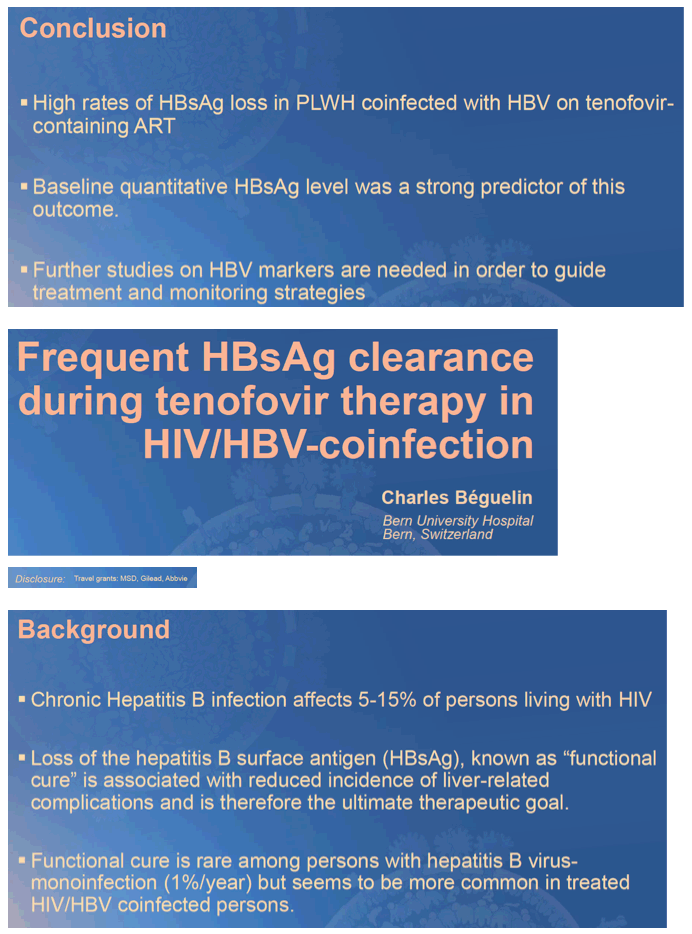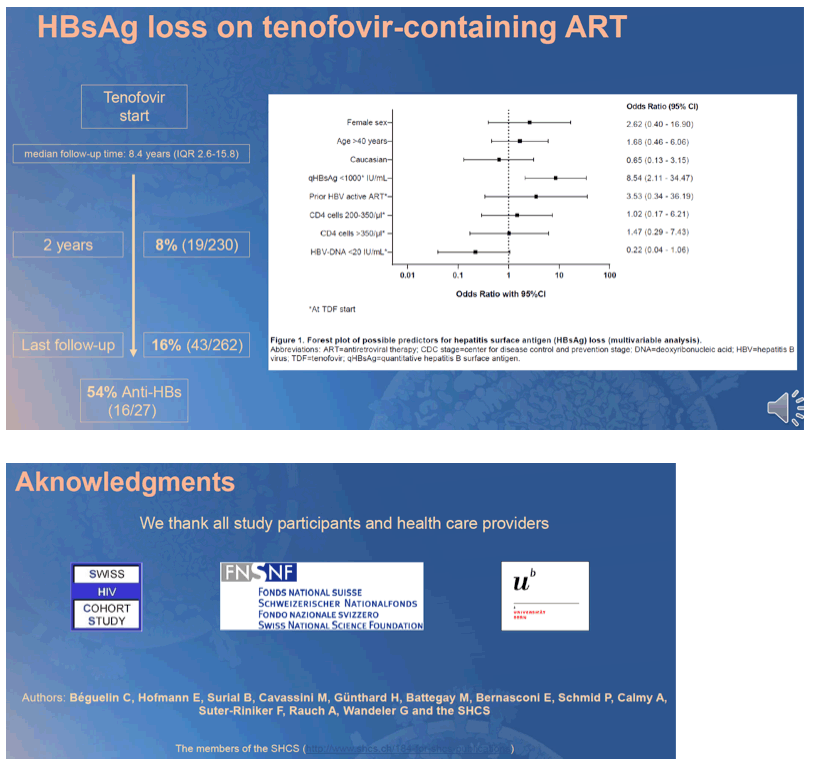 |
 |
 |
| |
FREQUENT HBsAg CLEARANCE DURING TENOFOVIR THERAPY IN HIV/ HBV COINFECTION
|
| |
| |
CROI 2021 March 6-10 Reported by Jules Levin
Charles Beguelin , Bernard Surial , Eveline Hofmann , Matthias Cavassini , Huldrych F. Günthard , Manuel Battegay , Enos Bernasconi , Patrick Schmid , Alexandra L. Calmy , Franziska Suter-Riniker , Andri Rauch , Gilles Wandeler , for
the Swiss HIV Cohort Study UniversityHospitalofBern,Bern,Switzerland, LausanneUniversityHospital, Lausanne,Switzerland, UniversityHospitalZurich,Zurich,Switzerland, University HospitalBasel,Basel,Switzerland, RegionalHospitalofLugano,Lugano, Switzerland, CantonalHospitalofStGallen,StGallen,Switzerland, University HospitalsofGeneva,Geneva,Switzerland, UniversityofBern,Bern,Switzerland
Background: Among persons with hepatitis B virus (HBV)-monoinfection, loss of the hepatitis B surface antigen (HBsAg), also described as HBV functional cure, is a rare event but associated with reduced incidence of liver-related complications. We aimed to assess the proportion of HBV functional cure among persons with HIV/HBV-coinfection during long-term tenofovir-therapy who experienced HBV functional cure, and to evaluate the association between quantitative HBsAg (qHBsAg) levels and this outcome.
Methods: All Swiss HIV Cohort Study participants with two positive HBsAg more than 6 months apart, and at least 4 years on tenofovir-containing antirertroviral therapy (ART) were considered. Our main outcomes were the loss of HBsAg during the first 2 years of tenofovir therapy and until the last available follow-up. We explored the association between qHBsAg levels at tenofovir start and HBsAg loss using multivariable logistic regression adjusted for gender, age, ethnicity, HIV transmission group, CD4 count (<350/μl), as well as for HBV suppression (<20 IU/mL) and low qHBsAg (<1000 IU/mL) at tenofovir start.
Results: A total of 272 patients were included. Median age was 41 years (IQR 36-46) and 221 (81%) were men. At tenofovir start, 110 (49%) patients were hepatitis B envelope antigen (HBeAg) positive, 229 (84%) had detectable HBV-DNA (median 1050 IU/ml, IQR 89-1.1x10E6) and 21% had low qHBsAg. HBsAg loss was observed in 8% (19/230) of participants during the first 2 years of tenofovir-containing ART and in 16% (43/262) of them after a median follow-up time of 8.4 years (IQR 2.6-15.8). At the last follow up, 54% (16/27) of those with HBsAg loss seroconverted for Anti-HBs antibodies. In multivariable analysis, low qHbsAg at tenofovir start (OR 12.01, CI 2.50-57.71) as well as female gender (OR 9.15, CI 1.08-77.45) were significant predictors of HBsAg loss, whereas this outcome was less likely among participants with negative baseline HBV DNA (OR 0.14, CI 0.02-0.79).
Conclusion: We found high rates of HBsAg loss in PLWH coinfected with HBV on tenofovir-containing ART, and baseline quantitative HBsAg level was a strong predictor of this outcome.



|
| |
|
 |
 |
|
|